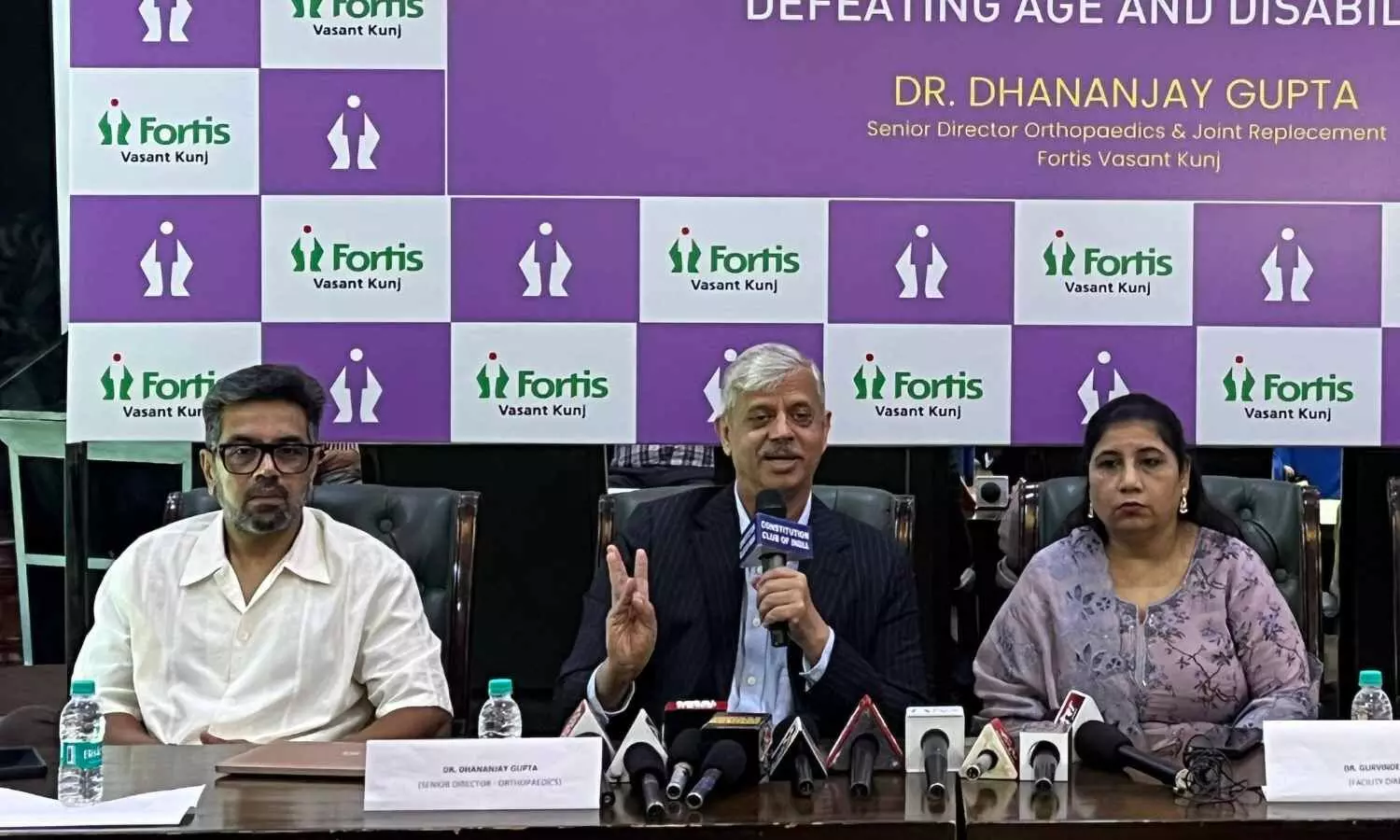Regular exercise could reduce the severity of hangovers
Powered by WPeMatico
Powered by WPeMatico
Powered by WPeMatico
Powered by WPeMatico

New Delhi: Dr Shiv Joshi has been elected as a Medical Ethics Officer in the World Medical
Association’s Junior Doctors Network. Dr Shiv Joshi is currently serving as a National Consultant at the World Health Organization (WHO) in its National Tuberculosis Elimination Programme Technical Support Network.
The election was held in hybrid mode in Helsinki, Finland on 15th October 2024. The World Medical Association, now encompassing 114 member countries, is dedicated to the highest standards of medical education, science, and ethics, ensuring quality health care for all people worldwide. His research interests include Epidemiology, Infectious diseases, Geriatric Health, Global Public Health, and Health Policy. He holds an MBBS, MD, PGDGM, CHR PGDBHL, and ICPBHR (UNESCO).
Dr Joshi has
pursued his MD in Community Medicine from Mahatma Gandhi Institute of Medical Sciences.
He completed his Postgraduate Diploma in Bio ethics and Health Law. He acted as
the National advisor of the Students Network Organisation which is a students’ wing
of the network- Towards Unity for Health (NGO affiliated to WHO). He has also
acted as the International Steering Committee member and UNESCO Chair in Bioethics
Students Association International. He has been a member of the World Medical
Association’s Junior Doctors’ Network since 2019.
Talking to
Medical Dialogues, Dr Shiv Joshi stated, “I am responsible for liaising with
the medical assistance team of the World Medical Association. As a Medical Ethics
Officer of WMA’s Junior Doctors Network, my responsibility is to ensure that
doctors are not facing discrimination or segregation or are not being exploited
in any unethical way. Thus, my work revolves around the ethical concern of the
medical community.”
“India is going to
be a potential leader in medical community building and it is extremely
important to engage the junior resident doctors who can be the future leaders.
For the coming generation of doctors, I would like to ask them to be a part of
an association such as the Indian Medical Association and to actively participate.
This is the only way to resolve the issues that the doctors face regularly to improve the health care of the country,” he added.
Powered by WPeMatico

New Delhi: Doctors at Fortis Hospital Vasant Kunj have successfully performed a total knee replacement surgery on a 97-year-old woman, enabling her to regain mobility and independence despite suffering from severe osteoarthritis.
The surgery was led by Dr Dhananjay Gupta, Director, Orthopaedic, Replacement, and Reconstructions at Fortis Hospital Vasant Kunj, and was supported by a multidisciplinary team that ensured her safe recovery.
Following the successful procedure, the patient was discharged in stable condition, marking a milestone in elderly orthopaedic care. She is the oldest Indian to have undergone knee replacement surgery at the hospital.
The patient, Mrs. Resham Devi, who has been living independently in an ashram in Vrindavan for the past 30 years, experienced a fall last year that resulted in a fracture and dislocation of her left hip.
Also Read:Fortis Hospital Doctors successfully remove 3 cm live cockroach from patient’s intestine via endoscopy
Though initially treated conservatively due to her frail condition, she continued to face significant mobility challenges due to a flexion deformity in her hip and advanced osteoarthritis in both knees. Determined to live independently and with dignity, Mrs. Devi advocated for a double knee replacement to fully regain her mobility.
Upon admission, Mrs. Devi presented with limited movement and severe pain in both knees and her left hip. Over six months, she underwent extensive physiotherapy and pre-surgical preparation, including injections of Teriparatide, calcium, and Vitamin D supplements to strengthen her bones. Despite this, she struggled with daily activities and remained dependent on assistance.
Given her age and the complexity of her condition, Dr. Gupta and his team initially recommended a single knee replacement, with the option for the second knee replacement three months later. However, Mrs. Devi expressed a strong desire to undergo both surgeries simultaneously. After a comprehensive pre-anaesthesia checkup, including bloodwork, liver and kidney evaluations, and cardiac assessments, she was cleared for the dual surgery.
After successfully completing the left knee replacement, the surgical team monitored Mrs. Devi’s vital signs closely. With no adverse readings, they proceeded with the right knee replacement. Following the surgery,
she was kept in the ICU for overnight observation and pain management. By the following day, she was mobilized with a walker, signalling the beginning of her recovery journey.
Dr. Dhananjay Gupta, Director Orthopaedic, Replacement, and Reconstructions at Fortis Hospital Vasant Kunj, said , “This was an extremely challenging case, given the patients advanced age and the complexities involved in her condition. Had this surgery been delayed, she would have continued to suffer from severely limited mobility, which could have significantly impacted her quality of life and emotional well-being.
Immobility in elderly patients is closely associated with increased risks of anxiety, depression, and a general decline in health. Physical mobility is crucial for seniors as it helps maintain bone and muscle mass, as well as cardiac and respiratory health. We hope that Mrs. Devi’s remarkable recovery and determination inspire others to seek timely intervention for conditions that hinder daily functioning and overall quality of life.”
Dr Gurvinder Kaur, Facility Director, Fortis Hospital Vasant Kunj, added , “This was a particularly challenging case, but our dedicated team handled it with expertise and compassion. Fortis Hospital Vasant Kunj is equipped with experienced clinicians and advanced technology, enabling us to take on complex cases and deliver high-quality outcomes. Mrs. Devi’s story serves as an inspiration, showing that age should not be a barrier to seeking treatment.”
Also Read:18 km in 13 minutes: Green Corridor Enables Heart Transplant for 34-year-old at Gurugram Hospital
Powered by WPeMatico

UK: Researchers have found in a new study that Greater calcium burden is associated with a lower level of vascular inflammation and plaque vulnerability. Further it may represent advanced stable plaque without significant inflammatory activity.
The research has appeared in the journal of American college of Cardiology.
The research Investigates relationship between coronary artery calcium burden, vascular inflammation, and plaque vulnerability. It is known that coronary artery calcification is an integral part of atherosclerosis. Further early coronary artery calcification is associated with active inflammation and which is also an important factor in plaque vulnerability.
In the accompanying editorial published in JACC: Cardiovascular Imaging, Charalambos Antoniades and Kenneth Chan from the University of Oxford explore the evolving landscape of cardiovascular risk assessment, highlighting the importance of understanding calcification and inflammation in atherosclerosis.
For over two decades, coronary calcification has served as a key imaging biomarker, primarily through computed tomography (CT), to identify high-risk individuals for primary prevention. As research has progressed, it has become clear that while calcified plaques indicate stability and reflect vascular aging, non-calcified plaques pose a higher risk of rupture, leading to acute coronary syndromes (ACS).
The editorial notes that statin therapy has been effective in inducing calcification of vulnerable non-calcified plaques, thereby reducing cardiovascular risk. However, calcification should not overshadow the emerging significance of vascular inflammation. This inflammation is now recognized as a critical factor in plaque development and destabilization, emphasizing the need for targeted therapies that address inflammatory processes.
Antoniades and Chan also point out that traditional systemic blood biomarkers, such as high-sensitivity C-reactive protein, lack specificity for vascular inflammation and provide only modest prognostic value. They highlight a breakthrough in identifying inflammation through the measurement of pericoronary adipose tissue (PCAT) using a novel Fat Attenuation Index (FAI). This index allows for a noninvasive assessment of coronary inflammation, showing promising prognostic value independent of calcium scores.
The editorial references recent research by Fujimoto et al. that examined the relationship between calcified plaque burden, vascular inflammation, and plaque vulnerability in a cohort of patients with non-ST-segment elevated ACS and stable angina. Their findings reinforce that higher calcified plaque burden correlates with lower rates of ACS, whereas lower calcification is associated with vulnerable plaque features indicative of inflammation.
Antoniades and Chan emphasize the importance of these findings in clinical practice, noting that understanding the distinction between stable calcified plaques and unstable non-calcified plaques is crucial for effective cardiovascular risk assessment. The editorial suggests that coronary calcification serves as a marker for stable atherosclerosis, potentially missing the inflammatory risks that drive acute coronary events.
While acknowledging the limitations of cross-sectional studies, the authors argue for the necessity of standardized metrics in evaluating coronary inflammation to facilitate clinical translation. They call for further large-scale studies using the FAI Score, linked with longitudinal outcomes, to elucidate the interplay between coronary plaque inflammation and calcification.
In conclusion, the editorial posits that a comprehensive approach to cardiovascular risk assessment should integrate both calcification and inflammation metrics. The authors advocate for a paradigm shift that recognizes the “power of zero inflammation” as equally, if not more, critical than the “power of zero calcium” in modern cardiovascular prevention strategies.
Reference:
Relationship Between Calcified Plaque Burden, Vascular Inflammation, and Plaque Vulnerability in Patients With Coronary Atherosclerosis
Daichi Fujimoto, Daisuke Kinoshita, Keishi Suzuki, Takayuki Niida, Haruhito Yuki, Iris McNulty, Hang Lee, Hiromasa Otake, Junya Shite, Maros Ferencik, Damini Dey, Tsunekazu Kakuta, and Ik-Kyung Jang
J Am Coll Cardiol Img. 2024 Oct, 17 (10) 1214–1224
https://www.jacc.org/doi/10.1016/j.jcmg.2024.07.013
Antoniades C, Chan K. Calcification vs Inflammation: The Modern Toolkit for Cardiovascular Risk Assessment. JACC Cardiovasc Imaging. 2024 Oct;17(10):1225-1228. doi: 10.1016/j.jcmg.2024.08.006. PMID: 39384268.
Powered by WPeMatico

Iran: A recent randomized study revealed that the combination of empagliflozin (EMPA) and topiramate (TPM) alongside calorie restriction resulted in a significant reduction in body weight and was generally well-tolerated in non-diabetic individuals with overweight or obesity, a recent randomized study has revealed.
“Additional research is needed to assess the long-term benefits of this combination for effective and sustained weight management,” Majid Valizadeh, Obesity Research Center, Research Institute for Endocrine Sciences, Shahid Beheshti University of Medical Sciences, Tehran, Iran, and colleagues wrote in Eating and Weight Disorders.
The study explored the effectiveness of combining empagliflozin, an SGLT2 inhibitor, and topiramate, an anticonvulsant commonly used for weight loss, compared to a placebo in overweight or obese individuals without diabetes who are following a calorie-restricted diet.
In this study, 44 non-diabetic individuals with overweight or obesity who were following a calorie-restricted diet were randomly divided into two groups: (1) one group received a daily 10 mg empagliflozin (EMPA) tablet along with topiramate (TPM), starting with 25 mg once daily in the first week and increasing to 25 mg twice daily from the second week; (2) the other group received daily placebos for both empagliflozin and topiramate, following the same schedule as the active treatment, for 12 weeks.
Evaluations for weight, height, body mass index (BMI), waist circumference (WC), and body composition were conducted at baseline and weeks 4, 8, and 12. Additionally, blood pressure, C-reactive protein, and parameters related to glucose and lipid profiles were measured before and after the intervention.
The following were the key findings of the study:
The findings showed that the 12-week administration of EMPA/TPM along with calorie restriction in overweight, non-diabetic patients resulted in a notable decrease in body weight, BMI, and fat mass, with participants generally tolerating the treatment well. However, there were no significant changes in waist circumference, glycemic and lipid profiles, blood pressure, or inflammation between the two groups.
Reference:
Abiri, B., Ramezani Ahmadi, A., Hosseinpanah, F. et al. Randomized study of the effects of empagliflozin and topiramate dual therapy on anthropometric and metabolic indices in non-diabetic individuals with overweight/obesity on a calorie-restricted diet. Eat Weight Disord 29, 64 (2024). https://doi.org/10.1007/s40519-024-01692-2
Powered by WPeMatico

A new study published in the journal of Open Forum Infectious Diseases showed that older adults hospitalized with respiratory syncytial virus (RSV) infections have a higher risk of dying within 90 days of admission than patients admitted with influenza B, but comparable to those admitted with influenza A.
Adults who have severe acute respiratory infections (SARI) have been linked to respiratory syncytial virus in recent years. Adults with underlying comorbidities such as immunodeficiency and chronic obstructive pulmonary disease (COPD) are more susceptible to severe RSV infection, which increases the risk of adverse outcomes and a worsening of the condition. Adults with RSV can experience mild cold-like symptoms all the way up to severe respiratory distress. According to recent research conducted in the USA and Israel, hospitalizations associated to RSV are less common than influenza, but the severity of RSV infection is on par with or even higher than influenza. This study was to compare the clinical features and symptoms of individuals hospitalized with RSV to those hospitalized with influenza A or B. Also, to compare the illness severity and fatality rates of RSV and influenza A and B patients. And lastly to determine the risk factors for death in RSV and influenza A and B patients.
After controlling for covariates, this multicenter observational cohort study examined the clinical symptoms, mortality risk factors and correlation with 90-day mortality by logistic regression analysis among persons hospitalized with RSV or influenza A or B between March 2016 and April 2020. Out of the 988 patients that were admitted to the hospital, 353 had RSV, 288 had influenza B and 347 had influenza A. Patients with RSV were more likely to have pneumonia and comorbidities when compared to influenza A and B. RSV infection was linked, relative to influenza B infection but not influenza A infection, to a higher all-cause mortality within 90 days after covariate correction. In patients with RSV, becoming older and having pneumonia at the time were found to be independent risk factors for death. Overall, RSV-induced acute respiratory infections cause considerable morbidity and death in older persons.
Source:
Clausen, C. L., Egeskov-Cavling, A. M., Hayder, N., Sejdic, A., Roed, C., Gitz Holler, J., Nielsen, L., Eiberg, M. F., Rezahosseini, O., Østergaard, C., Barrella Harboe, Z., K Fischer, T., Benfield, T., & Lindegaard, B. (2024). Clinical manifestations and outcomes in adults hospitalized with respiratory syncytial virus and influenza A/B: A multicenter observational cohort study. In Open Forum Infectious Diseases. Oxford University Press (OUP). https://doi.org/10.1093/ofid/ofae513
Powered by WPeMatico

With cardiovascular disease remaining a leading cause of death worldwide, a new study has highlighted strawberries as a natural and delicious way to support heart health and manage cholesterol. This research revealed significant health benefits associated with regular consumption of strawberries between (1 and 4 cups per day), particularly in improving cardiometabolic health.
Conducted by researchers from the University of California, Davis and funded by the California Strawberry Commission, the literature review, published in the September 2024 issue of Critical Reviews in Food Science and Nutrition, consolidated findings from 47 clinical trials and 13 observational studies published between 2000 and 2023. It concluded that strawberries are packed with beneficial phytonutrients like polyphenols and fiber, which help lower levels of LDL cholesterol and triglycerides while reducing inflammation. The result is enhanced overall heart health and better management of cardiovascular risk factors.
Whether fresh, frozen or in freeze-dried form, a daily dose of strawberries can have a substantial impact on cardiometabolic health especially in those at higher risk for heart disease. By improving lipid metabolism and reducing systemic inflammation, strawberries aid in lowering the risk of developing cardiovascular conditions.
“Strawberries are rich in phytonutrients that benefit heart health,” said Roberta Holt, Ph.D., lead researcher of the study at University of California, Davis. “Our review found that regular strawberry consumption not only lowers cholesterol but also helps reduce inflammation, which is a key driver of heart disease. This means that simply adding a cup of strawberries to your daily routine can significantly reduce your risk of cardiovascular events.”
Beyond heart health, the study reveals exciting benefits for brain health. This research suggests strawberries may help delay cognitive decline and protect against dementia, thanks to their rich flavonoid content. Strawberries may support cognitive function and combat oxidative stress, key factors in keeping the brain sharp as we age.
Toby Amidor, M.S., R.D.N., C.D.N., F.A.N.D., noted, “People are seeking natural, food-based solutions to manage their health and strawberries offer a convenient, delicious and affordable way to support heart health. They are packed with phytonutrients, fiber and vitamins, particularly vitamin C, and can be easily added to smoothies, yogurt, salads or eaten as a snack.”
Amidor joined the California Strawberry Commission team at the recent Food & Nutrition Conference and Expo on October 6-8 in Minneapolis, where they connected with thousands of registered dietitian nutritionists to share key nutrition and sustainability messages, alongside California strawberry grower Neil Nagata.
Reference:
Charoenwoodhipong, P., Zuelch, M. L., Keen, C. L., Hackman, R. M., & Holt, R. R. (2024). Strawberry (Fragaria x Ananassa) intake on human health and disease outcomes: a comprehensive literature review. Critical Reviews in Food Science and Nutrition, 1–31. https://doi.org/10.1080/10408398.2024.2398634.
Powered by WPeMatico

Thanks to advances in breast cancer research and personalized treatment approaches, patients diagnosed with breast cancer now have more surgical options than ever before. Among these innovative approaches is the Nipple-Sparing Mastectomy (NSM)—a procedure that not only removes the cancerous tissue but also preserves the nipple and much of the breast’s natural appearance.
Nipple-Sparing Mastectomy (NSM) is a surgical option for patients requiring a mastectomy, in which the breast tissue is removed while the skin, nipple, and areola remain intact. This procedure allows for immediate reconstruction and offers a more natural post-surgery result, giving patients both peace of mind and a sense of body confidence.
“In the past, patients with breast cancer had fewer options, often facing radical mastectomies that involved not only the removal of breast tissue but also the skin, lymph nodes, and chest muscles,” notes M. Michele Blackwood, MD, FACS, director of Breast Surgery and director of Women’s Oncologic Health, RWJBarnabas Health and Rutgers Cancer Institute; and Head of Breast Surgery at Cooperman Barnabas Medical Center. “While these procedures were life-saving, they could leave patients with significant physical and emotional scars.”
However, with Nipple-Sparing Mastectomy, advancements in understanding cancer biology and the ability to detect cancers earlier have allowed surgeons to shift toward breast conservation.
How Nipple-Sparing Mastectomy WorksDuring NSM, the surgeon carefully removes the breast tissue while preserving the skin, nipple, and areola. This requires precision to ensure that all cancerous cells are removed while keeping the remaining tissue healthy.
“One of the benefits of NSM is the option for immediate breast reconstruction, which can be done using either implants or tissue from another part of the body, such as in the DIEP flap procedure, which also provides a mini tummy tuck effect,” says Dr. Blackwood. “Some patients may also benefit from oncoplastic surgery, which combines the removal of the tumor with plastic surgery techniques to improve the overall aesthetic result.”
Benefits of Nipple-Sparing MastectomyPatients who qualify for NSM can experience both physical and emotional benefits:
Not all breast cancer patients are candidates for NSM. Factors such as the size and location of the tumor, as well as the overall health of the patient, play a role in determining eligibility. Patients should have tumors that are small, non-invasive, and located away from the nipple. Surgeons also consider whether the cancer has spread to the lymph nodes or skin.
The Future of Breast Cancer SurgeryThe field of breast cancer surgery continues to evolve, with a focus not only on removing the cancer but also on the quality of life for survivors. Surgeons are now integrating breast preservation and cosmetic outcomes into their treatment plans, ensuring that patients receive the best possible care in terms of both survival and appearance.
Nipple-Sparing Mastectomy represents a significant step forward in breast cancer treatment, providing patients with a chance to maintain a natural look while effectively treating their disease. “Thanks to advances in research and surgical techniques, women facing a breast cancer diagnosis now have options that not only focus on survival but also on long-term well-being and self-confidence,” said Dr. Blackwood.
Powered by WPeMatico
